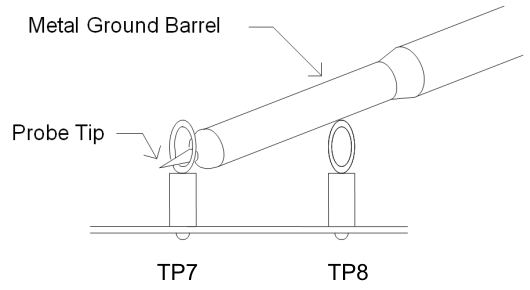SLUU943A May 2012 – December 2021 TPS53014
5.1 Test Equipment
Voltage Source:
- VIN: The input voltage source, VIN, should be a 0-V to 30-V variable DC source capable of supplying 2 ADC. Connect VIN to J1 as shown in Figure 5-2.
Multimeters:
- V1: VIN at TP1 (VIN) and TP2 (GND), 0-V to 30-V voltmeter
- V2: VOUT at TP7 (VOUT) and TP8 (GND)
- A1: VIN input current, 0-ADC to 2-ADC Ammeter
Output Load: The output load should be an electronic constant resistance mode load capable of 0 ADC to 8 ADC at 1.05 V.
Oscilloscope: A digital or analog oscilloscope can be used to measure the output ripple. The oscilloscope should be set for the following:
- 1-MΩ impedance
- 20-MHz bandwidth
- AC coupling
- 1-µs/division horizontal resolution
- 50-mV/division vertical resolution
 Figure 5-1 Tip and Barrel Measurement for VOUT Ripple
Figure 5-1 Tip and Barrel Measurement for VOUT RippleFan: Some of the components in this EVM may approach temperatures of 85°C during operation. A small fan capable of 200 LFM to 400 LFM is recommended to reduce component temperatures while the EVM is operating. The EVM should not be probed while the fan is not running.
Recommended Wire Gauge:
- VIN to J1: The recommended wire size is 1x AWG #16 per input connection, with the total length of wire less than four feet (2 feet input, 2 feet return).
- J2 to LOAD: The minimum recommended wire size is 1x AWG #16, with the total length of wire less than four feet (2 feet output, 2 feet return)